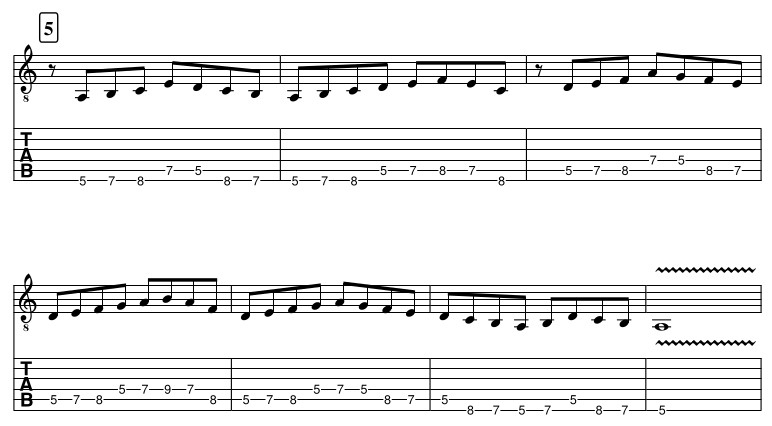Dominate your Scales!
Examples of practice routines for scale studies:
In this article we’re going to look at just a few ways you can take a single scale and drill it various ways into really useful exercises. These techniques can be applied to nearly every facet of the guitar. With a little creativity, you can come up with endless amounts of useful licks using only one scale.
This is the A Minor scale, in 5th position. Ascending and descending. We’ll be looking at ways to come up with variations on this scale to help with memorization, improvisation, technique, and speed.
In the first example we have a sequence. We use the first 5 notes of the scale, then descend back to the starting position. The sequence repeats three times, then in measure 4 we use a similar sequence starting on a different pitch (C).
Here we have the same idea as the previous, only starting on a different pitch as well as a different string group. This could also loosely be considered D minor, although we’re not going to get into all that. Right now it’s just a collection of pitches we call A minor. Substituting the fingering in measure 4 with a stretch to the 9th fret is another option.
For example 3, hold back your phrase for a full beat, and start the sequence at beat two. Using a metronome, or playing with a backing track will show you that playing it in this fashion will feel totally different.
Now we make the phrase even more challenging by shortening the rest. Let’s have the phrase start on an even weaker pulse. Again, use a metronome or play to a backing track to really get a sense of how different this will sound and feel in context. If you’re practicing these without context, it will only make it more difficult to translate to real world conditions.
In example 5, I’m bringing it all together. We’ve have 8th note rests. Then, full statements of the sequence (measure 2). Which leads to the same motifs presented on different string groups (measure 3-5).
These are just short examples of creative ways to drill scales and come up with interesting phrases and licks. There are many many ways to come up with your own. Put effort into these studies if your interest lays in lead guitar/improvisation. Adding a creative improvisation routine to your practice regiment will not only help you come up with ideas faster, it will also stop you from using the same old tried and true licks.












Really dig the practice scale top page..and the examples leading into 5..Keeping my focus all on acoustic these get challenging. HAHA!
practice sloooooooly!
🙂